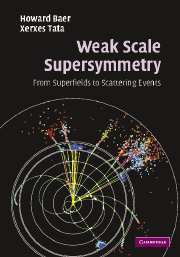Book contents
- Frontmatter
- Contents
- Preface
- 1 The Standard Model
- 2 What lies beyond the Standard Model?
- 3 The Wess–Zumino model
- 4 The supersymmetry algebra
- 5 Superfield formalism
- 6 Supersymmetric gauge theories
- 7 Supersymmetry breaking
- 8 The Minimal Supersymmetric Standard Model
- 9 Implications of the MSSM
- 10 Local supersymmetry
- 11 Realistic supersymmetric models
- 12 Sparticle production at colliders
- 13 Sparticle decays
- 14 Supersymmetric event generation
- 15 The search for supersymmetry at colliders
- 16 R-parity violation
- 17 Epilogue
- Appendix A Sparticle production cross sections
- Appendix B Sparticle decay widths
- Appendix C Higgs boson decay widths
- Bibliography
- Index
5 - Superfield formalism
- Frontmatter
- Contents
- Preface
- 1 The Standard Model
- 2 What lies beyond the Standard Model?
- 3 The Wess–Zumino model
- 4 The supersymmetry algebra
- 5 Superfield formalism
- 6 Supersymmetric gauge theories
- 7 Supersymmetry breaking
- 8 The Minimal Supersymmetric Standard Model
- 9 Implications of the MSSM
- 10 Local supersymmetry
- 11 Realistic supersymmetric models
- 12 Sparticle production at colliders
- 13 Sparticle decays
- 14 Supersymmetric event generation
- 15 The search for supersymmetry at colliders
- 16 R-parity violation
- 17 Epilogue
- Appendix A Sparticle production cross sections
- Appendix B Sparticle decay widths
- Appendix C Higgs boson decay widths
- Bibliography
- Index
Summary
We saw in Chapter 3 how the Wess–Zumino model could be formulated in terms of the fields S, φL, and the auxiliary field F, which transform into each other under a supersymmetry transformation. Here, we simply “pulled a Lagrangian out of a hat”, and verified by brute force that (at least the free part of) this Lagrangian led to a supersymmetric action. While this example was instructive, it provided no guidance as to how to write down other more complicated supersymmetric theories. We alluded, however, to the fact that we could think of the fields, S, φL, and F as the components of a single entity, a chiral superfield.
The superfield formalism provides a convenient way to formulate general rules for the construction of supersymmetric Lagrangians, even for theories with non-Abelian gauge symmetry that are the foundation of modern particle physics. The superfield calculus that we develop in this and succeeding chapters will provide us with a constructive procedure for writing down theories that are guaranteed to be supersymmetric. This procedure will ultimately be used to write down the simplest supersymmetric extension of the Standard Model. This theory, augmented with suitable soft supersymmetry breaking terms, is known as the Minimal Supersymmetric Standard Model, or MSSM.
Superfields
To begin, we would like to somehow combine the fields S, φL, and F into a single “superfield”, in much the same way that the neutron and proton fields are combined into a single “nucleon” field in the isospin formalism.
- Type
- Chapter
- Information
- Weak Scale SupersymmetryFrom Superfields to Scattering Events, pp. 49 - 78Publisher: Cambridge University PressPrint publication year: 2006



